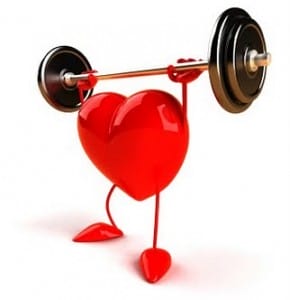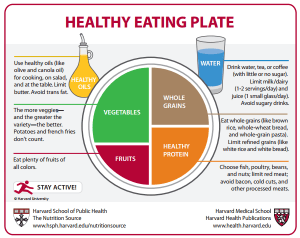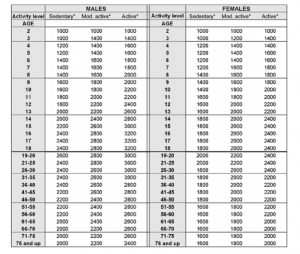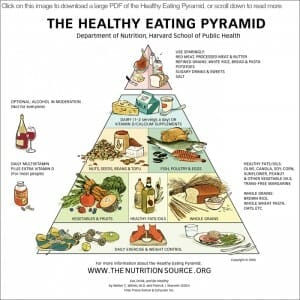Eating healthy is a crucial part of having a strong and injury free body. It can also change your life. Really – it lowers risk of heart disease, decreases depression, increases energy, decreases muscle tension, boosts the immune system and much, much more. In today’s post I want to bring together all the best nutritional and healthy eating guidelines to give you a clear and simple healthy food guide that will change the way you eat.

- Decreases Cardiovascular disease risk (Leading cause of death in America)
- Decreases blood pressure
- Increases energy
- Boosts the immune system
- Decreases cholesterol
- Normalise glucose levels
- Decrease weight
In order to give you the best, evidence based, up to date information I have combined recommendations from some of the top food guidelines around the world, including:
- Harvard University’s healthy eating pyramid
- Dietary Approaches to Stop Hypertension (DASH)
- The US Department of Agriculture’s healthy eating guidelines
- Diet and Lifestyle recommendations form the American heart association
- And more
Yes there a lot of guidelines out here, constantly throwing information and recommendations at you. Which is why it’s important to consolidate these and show you what they all have in common – because what all the recommendations have in common is the basis to eating healthy and having a great nutritional intake.
Your health eating guidelines:
It’s a lifestyle, not a diet
1. Vegetables
The amount of vegetables you should be eating (all the guides and recommendations were unanimous!) is 2.5 cups per day. The thing to keep in mid with this is that you should eat a variety of vegetables – different colors, shapes and flavors to get the best nutritional uptake. For example:
- Dark green, leafy veges
- Legumes (lentils, beans etc)
- Starchy veges
- Orange and red veges
2. Fruit
The amount of fruit recommended is 2-3 cups, and again you want a variety of colors here as well to really get all the antioxidants, vitamins and plenty of other goodies.
You should be consuming is 6-8 oz (170-230 gm). The key to this though is that at least half of these need to be whole grains. Whole grains are better for you as they have a high glycemic index – this means that they take longer to break down, so that they are slowly releasing the fuel into your body with means less highs and lows and more steady energy.
Examples of whole grains (eat most):
- Whole wheat
- Brown rice, wild rice
- Buckwheat
- Quinoa
- Corn
- Barley
- Oats/oatmeal
Examples of grains with a high glycemic index (use sparingly):
- White rice
- White bread
- Pasta
- Potatoes
4. Milk
You should be drinking 2-3 cups of milk or equivalent per day. All of the guidelines were agreeing on this except the Harvard healthy eating pyramid. This is because of a few reasons:
- Concern over the amount of saturated fat and calories in milk. A good way to get around this is to drink fat-free or low-fat milk – this is something that really should have caught on by now but still only 10% of all milk consumed by americans is fat-free (national health and nutrition survey 2001-02)
- Due to the prevalence of lactose intolerance: Absolutely if you are lactose intolerant then a few things you can do: Eat more of other foods that are full of calcium (the best option), consume milk with other foods and not on an empty stomach and take calcium and vitamin D supplements.
- Increased levels of unneeded hormones in some milk: Be carefull what milk you buy as increased levels of hormones have been associated with increased cancer risks. It is worth splashing out a little extra and buying hormone free or organic milk.
5. Meat, nuts and beans
You should be eating around 6 oz (170grams) of lean meat per day and 2-3 oz of nuts, seeds and beans per day.
Lean meats that you should be consuming is:
- Fish, poultry and lean beef and pork
Quick note: Do not deep fry your food if you can help it! Especially fish as this changes the good fats and nutrients in it. Try to grill, bake or broil it.
The amount of oils you should be consuming does vary a lot in all the research. The most common amount (and a good middle ground) is 6 teaspoons (27grams) per day.
For oil you should be using liquid vegetable oils (or products made form this) so that there is less Trans fatty acids.
7. Treats
These are normally called Discretionary calories. They’re calories from outside the recommended food groups. From things like; added sugar, sweets, alcohol, solid fat etc.
This is limited to 135 calories (4 teaspoons).
8. Alcohol
If you consume alcohol, do it in moderation, the recommended amount is one drink per week.
9. Total calorie intake
The average person should consume and use 2000 calories per day but this really does vary depending on the your activity levels, sex and age.
Check out this table for a good guide:
Source: My Pyramid, USDA
Body Composition is dependent on lifestyle changes, not memorizing lists, instructions or diets
Here is a handy list of tips to sum that up – easy to print out and put on the fridge!
Tips to improve your nutrition, health and general well-being:
- Eat fish (especially oily fish) at least twice a week.
- Consume a diet full of vegetables and fruit.
- Choose whole grain and whole fiber foods
- Prepare and eat smaller portions
- Choose leans meats and veg alternatives
- Drink fat-free or low-fat milk
- Minimise added sugars (so no to soft drinks and energy drinks to make an awesome difference!)
- Use vegetable oils instead of solid fats.
- Know your caloric needs to achieve and maintain a healthy weight.
- Grill, bake or broil your meat.
- Follow this healthy food guide when eating out as well!
It is important to make these changes gradually to your lifestyle to make changes THAT LAST. If you make wholesale changes where you start eating completely differently, this will for one; shock your body, and two; it will not last.
The more you take from this healthy food guide and make changes to your nutrition – the better off you will be in the long-term, and I know it is corny to say but it really will add years to your life.
We all need to make changes that will last, because life isn’t a fad and you only live once!
Please like and share with all your friends, they will thank you for it.
Scientific paper for more in-depth reading.




